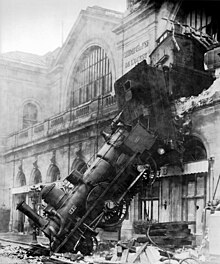Siderodromophobia

Siderodromophobia (from the Greek sidêros iron, dromos run, phobos fear) is the exaggerated fear or fear of trains, train travel or rails. It is also known as railroad fear. Compared to other phobias , it rarely occurs or is not recognized as such. Some of those affected fear derailments and rail accidents , others fear conductors they do not know .
Symptoms
Siderodromophobia can be acquired in the course of life through traumatic experiences or like other anxiety disorders (e.g. claustrophobia ). Like travel fever, symptoms can begin long before the actual trip. Some patients experience panic attacks , palpitations, sweating, indigestion, while others cry, freeze or flee. If left untreated, the phobia may worsen such that patients are no longer able to cross level crossings, walk past train stations, or not be startled when they hear a train horn.
Complications
The most obvious effect of siderodromophobia is being unable to use trains, subways, or trams. For some patients, it is not even possible to visit tourist attractions such as railway museums, amusement parks with railway-like rides or listed objects on which rails are laid.
treatment
Siderodromophobia is easy to treat with a good chance of success. Usually cognitive behavioral therapy is used, in which the thoughts and behavioral patterns are diverted from negative to positive. In addition, psychotherapy and drug treatment are used.
The effect of hypnosis and neuro-linguistic programming has been investigated with promising results, but has not yet been scientifically proven.
See also
Individual evidence
- ↑ a b Otto Dornblüth: Clinical Dictionary. 13/14. Edition. 1927.
- ↑ a b c Sigmund Freud: Lectures for the introduction to psychoanalysis. Reprint of the original from 1920 . Books on Demand, 2012, ISBN 978-3-86403-493-0 , pp. 465 .
- ↑ a b c d Lisa Fritscher: Understanding Siderodromophobia (Fear of Trains). May 27, 2014, accessed July 19, 2014 .
- ↑ Johannes Rigler: About the consequences of injuries on railways: especially injuries to the spinal cord; with regard to the Liability Act . Reimer, 1879.
- ^ Hermann Oppenheim: The traumatic neuroses. Edited reprint of the original edition from 1892 . Books on Demand, 2012, ISBN 978-3-8457-4269-4 , pp. 128 .
- ^ Emil Kraepelin: Introduction to the Psychiatric Clinic - Thirty-two Lectures. Reprint of the original from 1905 . Рипол Классик, ISBN 978-5-88054-758-6 , p. 290 .
- ^ JJ Seymour: Fear of Trains - How to Simply Overcome Phobia of Trains. October 10, 2008.
- ^ Tomasz Witkowski: Thirty-Five Years of Research on Neuro-Linguistic Programming. NLP Research Data Base. State of the Art or Pseudoscientific Decoration? In: Polish Psychological Bulletin 2010. Vol. 41 (2), pp. 58-66. ( online ( Memento of the original from October 9, 2014 in the Internet Archive ) Info: The archive link was automatically inserted and not yet checked. Please check the original and archive link according to the instructions and then remove this note .; PDF; 0.8 MB ( page no longer available , search in web archives ) Info: The link was automatically marked as defective. Please check the link according to the instructions and then remove this notice. ).
- ^ R. Wiseman, C. Watt, L. ten Brinke, S. Porter, SL Couper, C. Rankin: The eyes don't have it: lie detection and Neuro-Linguistic Programming. In: PLOS ONE . 2012; 7 (7), p. E40259. doi: 10.1371 / journal.pone.0040259 . PMID 22808128 .
